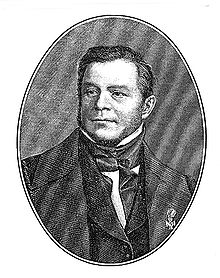August Kopisch
August Kopisch ( born May 26, 1799 in Breslau, † February 6, 1853 in Berlin) was a German history painter and writer.
Life
Kopisch was born the son of a wealthy businessman Breslauer Christian Gottlieb Kopisch. He visited the Mary Magdalene Gymnasium in Breslau to Prima. There he devoted himself since his childhood painting, he spent the years 1815-1818 at the art academies in Dresden and Prague. In October 1817 he went to Vienna, where students were at the Art Academy and studied by mid- 1819 the trade history painting. He hesitated at that time between painting and poetry and also played guitar and piano. In Vienna he enjoyed the special promotion by Professor Georg Joseph Meinert and Vuk Stefanović Karadžić of the philologist.
In the winter of 1820/21 he broke at a skating accident the right hand. Since the hand remained stiff, he gave up painting with a heavy heart and against the wishes of his family and devoted himself only the literature.
To cure his hand (and because he had unhappily in love with a kindred with him girl ), Kopisch off on a long journey to Italy in the spring of 1824. In Rome he was soon joined in the German Romans. 1826 remained Kopisch on in Naples. There he met August von Platen - Hallermünde know who influenced him also literary. Through his skill in swimming, he discovered together with the Heidelberg painters Ernst Fries in 1826, the Blue Grotto on Capri. In Naples Kopisch again began to paint and soon became a city well-known original, the residents only Don Augusto Prussiano called. Filippo Cammarano even made him a character in one of his popular comedies.
1828 Kopisch returned back to Wroclaw. From 1833 he lived in Berlin, where he found in the royal Hofmarschallamt a job, in 1840 appointed to the Royal Art Advisory Board and in 1844 by Crown Prince Friedrich Wilhelm IV was awarded the title of professor. From 1847 Kopisch stayed in Potsdam. In the revolutionary years 1848/49 to Kopisch behaved extremely loyal to the royal family.
On July 12, 1852 in Berlin Kopisch married Marie of Sellin. On a trip to Berlin August Kopisch suffered a stroke, he died on 6 February 1853. He was buried in a grave of honor in the city of Berlin in the OM G2 box on the Trinity Cemetery II in Berlin -Kreuzberg.
Works (selection)
- Literature Agrumi, volksthümliche symposia from all dialects of Italy and its islands. Crantz Verlag, Berlin 1838.
- All kinds of spirits. Poems and stories. Moerike Verlag, Munich 1913 ( with the ballad The elves of Cologne)
- Dieter Richter (ed.): The discovery of the Blue Grotto on the island of Capri. Wagenbach Verlag, Berlin 1997, ISBN 3-8031-1163-3.
- The Divine Comedy of Dante Alighieri. Metric translation plus beigedrucktem original texts. Curlew & Ranft, Berlin, 1887.
- Discovery of the Blue Grotto on the island of Capri, edited and with an afterword by Hans Glover, Scientia Verlag, Zurich, 1946, 74 pp.
- Poems (1836 )
- The elves of Cologne. Emons, Cologne 2007, ISBN 978-3-89705-493-6.
- A carnival on Ischia. Hausen, Saarlouis 1892.
- The royal palaces and gardens of Potsdam. From the time of its founding until 1852. Ernst & Korn, Berlin, 1854.
- My very first book of fairy tales: The brownies to Cologne. Edition palletizing, Cologne 2004, ISBN 3-89893-892-1.
- The dreamer. Hübener, Berlin 1948.
- Carl Hooper (ed.): The Collected Works. Weidmann, Berlin 1856 ( 5 vols )
- Radioplay The brownies and other stories from grandpa's old book (CD), Uccello -Verlag, ISBN 978-3-397337-80-7 ( ISBN formally wrong ).
- Painting The crater of Vesuvius Eruption of 1828 ( Painting 1828)
- A ship on the sea of dolphins swarmed (paintings )
- The Pontine Marshes ( painting, 1848)









